Research on Rolling-Element Bearing Composite Fault Diagnosis Methods Based on RLMD and SSA-CYCBD
Abstract
1. Introduction
2. Theoretical Basis of the Proposed Method
2.1. Local Mean Decomposition (LMD)
2.2. Robust Local Mean Decomposition (RLMD)
2.3. Sparrow Search Algorithm (SSA)
2.4. Maximum Second-Order Cyclostationarity Blind Deconvolution (CYCBD)
- (1)
- Initialize the filter h to obtain a series of filter coefficients;
- (2)
- The filtered signal s is obtained by performing a convolution operation on the collected noise-containing signal x and the filter h;
- (3)
- The maximum eigenvalue λ and its corresponding filter h are calculated by Equation (27);
- (4)
- The h calculated in step (3) is brought into step (2) to recalculate the filtered signal s until convergence.
3. Proposed Method
4. Simulation and Experimental Verification
4.1. Simulation Verification
4.2. Experimental Verification
5. Conclusions
Author Contributions
Funding
Data Availability Statement
Conflicts of Interest
References
- Zhang, K.; Zhou, D.H.; Chai, Y. Review of Composite Fault Diagnosis Technology. Control Theory Appl. 2015, 32, 1143–1157. [Google Scholar]
- Zhang, Y.Y.; Jia, Y.X.; Wu, W.Y.; Cheng, Z.H.; Su, X.B.; Lin, A.Q. A diagnosis method for the compound fault of gearboxes based on multi-feature and BP-AdaBoost. Symmetry 2020, 12, 461. [Google Scholar] [CrossRef]
- Ma, J.P.; Zhuo, S.; Li, C.W.; Zhan, L.W.; Zhang, G.Z. An enhanced intrinsic time-scale decomposition method based on adaptive lévy noise and its application in bearing fault diagnosis. Symmetry 2021, 13, 617. [Google Scholar] [CrossRef]
- Gustantsson, J.G.; Tallian, T. Detection of damage in assembled rolling bearing. Trans. ASLE 1962, 5, 197–209. [Google Scholar] [CrossRef]
- Shi, H.T.; Guo, J.; Yuan, Z. Incipient fault detection of rolling element bearings based on deep EMD-PCA algorithm. Shock. Vib. 2020, 2020, 1–17. [Google Scholar] [CrossRef]
- Liu, J.; Wang, L.; Tan, H. An extended EEMD method for localized faults detection of a planetary gearbox. J. Test. Eval. 2019, 47, 20180615. [Google Scholar] [CrossRef]
- Ma, C.; Wang, S.H.; Xu, X.L. Fault Diagnosis of Acoustic Array Rolling Bearing Based on EEMD. J. Electron. Meas. Instrum. 2017, 31, 1379–1384. [Google Scholar]
- Dong, W.; Tsui, K.L.; Yong, Q. Optimization of segmentation fragments in empirical wavelet transform and its applications to extracting industrial bearing fault features. Measurement 2019, 133, 328–340. [Google Scholar]
- Liu, C.; Zhang, L.; Niu, J. Intelligent prognostics of machining tools based on adaptive variational mode decomposition and deep learning method with attention mechanism. Neurocomputing 2020, 417, 239–254. [Google Scholar] [CrossRef]
- Wang, R.; Xu, L.; Liu, F. Bearing fault diagnosis based on improved VMD and DCNN. J. Vibroengineering 2020, 22, 1055–1068. [Google Scholar] [CrossRef]
- Liu, Z.L.; Jin, Y.Q.; Zuo, M.J. Time-frequency representation based on robust local mean decomposition for multicomponent AM-FM signal analysis. Mech. Syst. Signal Process. 2017, 95, 101. [Google Scholar] [CrossRef]
- Yan, S.T.; Zhou, Y.G.; Ren, Y.B. Bearing fault diagnosis method based on RLMD and Kmeans++. Mech. Transm. 2021, 45, 163–170. [Google Scholar]
- Wiggins, R.A. Minimumentropy deconvolution. Geoexploration 1978, 16, 21–35. [Google Scholar] [CrossRef]
- Cheng, Y.; Zhou, N.; Zhang, W. Application of an improved minimum entropy deconvolution method for railway rolling element bearing fault diagnosis. J. Sound Vib. 2018, 425, 53–69. [Google Scholar] [CrossRef]
- Chen, J.K.; Chen, X.H. Gear fault diagnosis model combined with MED-LMD-Hypersphere multiclass SVM. In Proceedings of the Prognostics and System Health Management Conference, Chongqing, China, 26–28 October 2018; pp. 1114–1119. [Google Scholar]
- Mcdonald, G.L.; Zhao, Q.; Zuo, M.J. Maximum correlated kurtosis deconvolution and application on gear tooth chip fault detection. Mech. Syst. Signal Process. 2012, 33, 237–255. [Google Scholar] [CrossRef]
- Li, L.F.; Guo, A.B.; Chen, H.Y. Feature extraction based on EWT with scale space threshold and improved MCKD for fault diagnosis. IEEE Access 2021, 9, 45407–45417. [Google Scholar] [CrossRef]
- Ma, T.W.; Zhang, X.F.; Jiang, H. Early fault diagnosis of shaft crack based on double optimization maximum correlated kurtosis deconvolution and variational mode decomposition. IEEE Access 2021, 13, 281–305. [Google Scholar] [CrossRef]
- Marco, B.; Jerome, A. Blind deconvolution based on cyclostationarity maximization and its application to fault identification. J. Sound Vib. 2018, 432, 569–601. [Google Scholar]
- Rilling, G.; Flandrin, P.; Goncalves, P. On empirical mode decomposition and its algorithms. In Proceedings of the 6th IEEE/EURASIP Workshop on Nonlinear Signal and Image Processing, Grado, Italy, 8–11 June 2003. [Google Scholar]
- Shokouhifar, M. Swarm intelligence RFID network planning using multi-antenna readers for asset tracking in hospital environments. Comput. Netw. 2021, 198, 108427. [Google Scholar] [CrossRef]
- Shokouhifar, M. FH-ACO: Fuzzy heuristic-based ant colony optimization for joint virtual network function placement and routing. Appl. Soft Comput. 2021, 107, 107401. [Google Scholar] [CrossRef]
- Esmaeili, H.; Hakami, V.; Minaei Bidgoli, B. Application-specific clustering in wireless sensor networks using combined fuzzy firefly algorithm and random forest. Expert Syst. Appl. 2022, 210, 118365. [Google Scholar] [CrossRef]
- Li, Y.L. Comparative Research on Several New Swarm Intelligence Optimization Algorithms. Comput. Eng. Appl. 2020, 56, 1–12. [Google Scholar]
- Zhao, M.; Lin, J.; Miao, Y. Detection and recovery of fault impulses via improved harmonic product spectrum and its application in defect size estimation of train bearings. Measurement 2016, 91, 421–439. [Google Scholar] [CrossRef]
- Schroeder, M.R. Period histogram and product spectrum: New methods for fundamental-frequency measurement. Acoust. Soc. Am. 1968, 43, 829–834. [Google Scholar] [CrossRef] [PubMed]
- Tang, G.; Wang, X.; He, Y. Diagnosis of compound faults of rolling bearings through adaptive maximum correlated kurtosis deconvolution. J. Mech. Sci. Technol. 2016, 30, 43–54. [Google Scholar] [CrossRef]
- Patil, A.P.; Mishra, B.K.; Harsha, S.P. Fault diagnosis of rolling element bearing using autonomous harmonic product spectrum method. Proc. Inst. Mech. Eng. Part K J. Multi-Body Dyn. 2021, 235, 361–411. [Google Scholar] [CrossRef]
- Seneff, S. Real-time harmonic pitch detector. IEEE Trans. Acoust. Speech Signal Process. 1976, 26, 358–365. [Google Scholar] [CrossRef]
- Wang, B.; Lei, Y.; Li, N. A hybrid prognostics approach for estimating remaining useful life of rolling element bearings. IEEE Trans. Reliab. 2018, 69, 401–412. [Google Scholar] [CrossRef]
- Lei, Y.G.; Han, T.Y.; Wang, B. XJTU-SY Rolling Bearing Accelerated Life Test Data Set Interpretation. J. Mech. Eng. 2019, 55, 1–6. [Google Scholar]
- Zhou, F.C. Research on Fault Diagnosis Method of Rolling Bearing Based on Cyclostationary Signal Processing; Shanghai Jiaotong University: Shanghai, China, 2006. [Google Scholar]
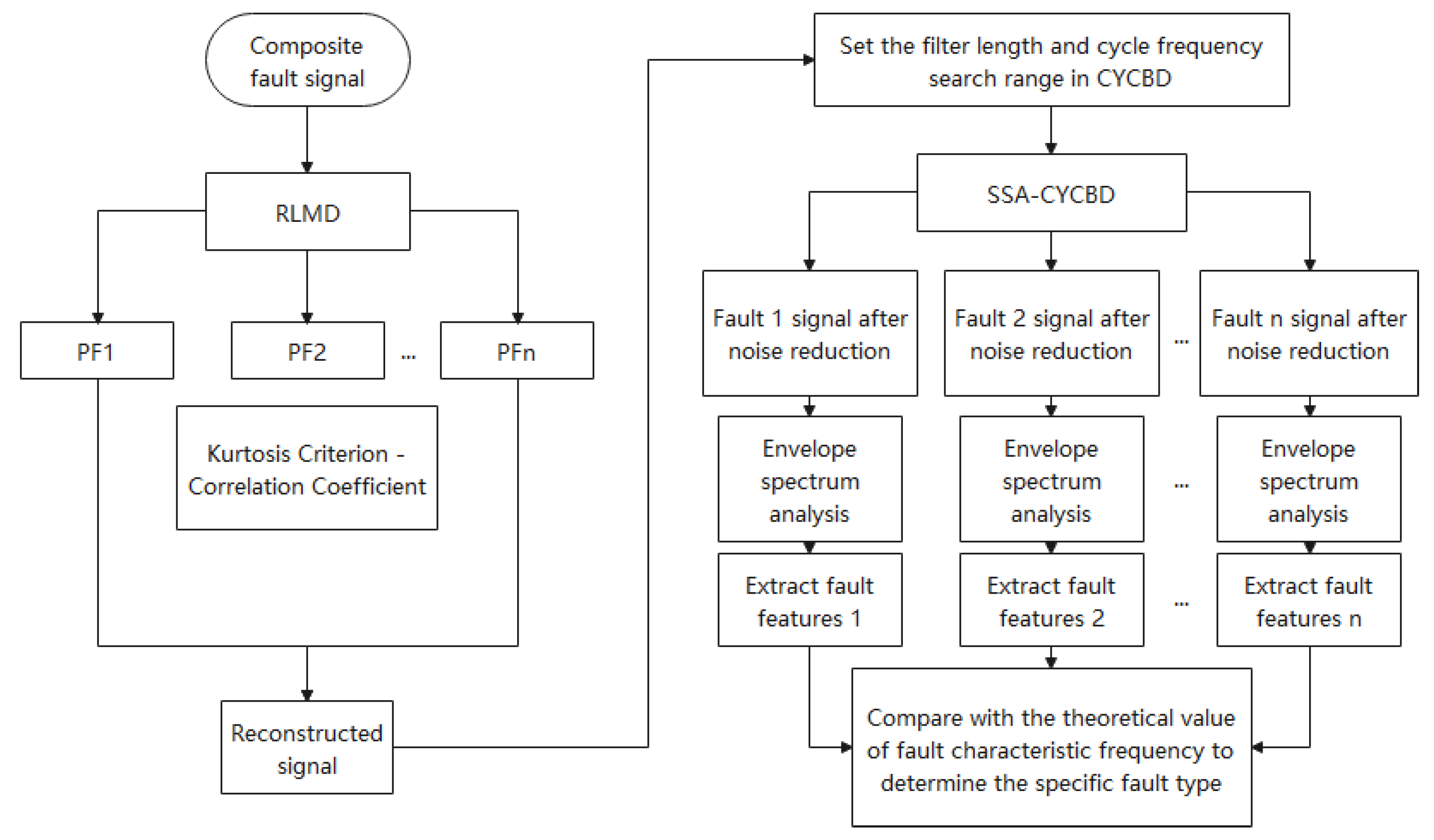


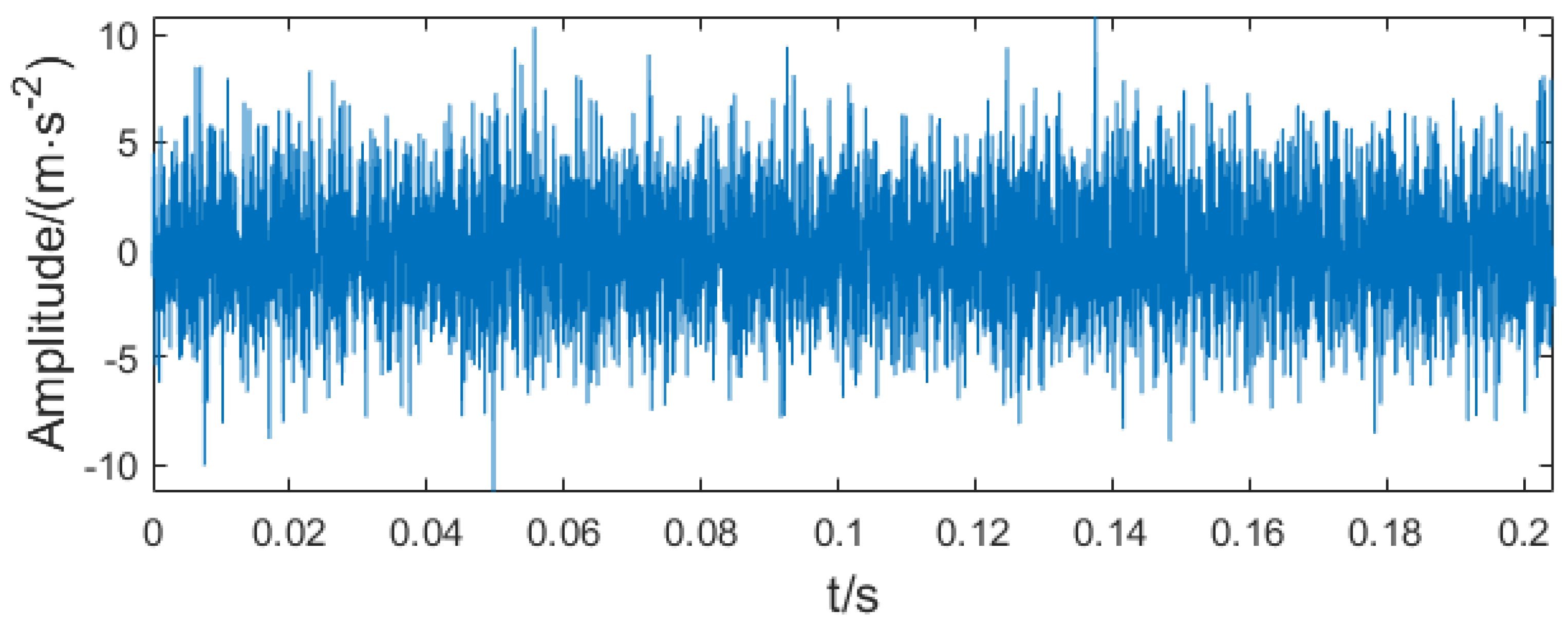
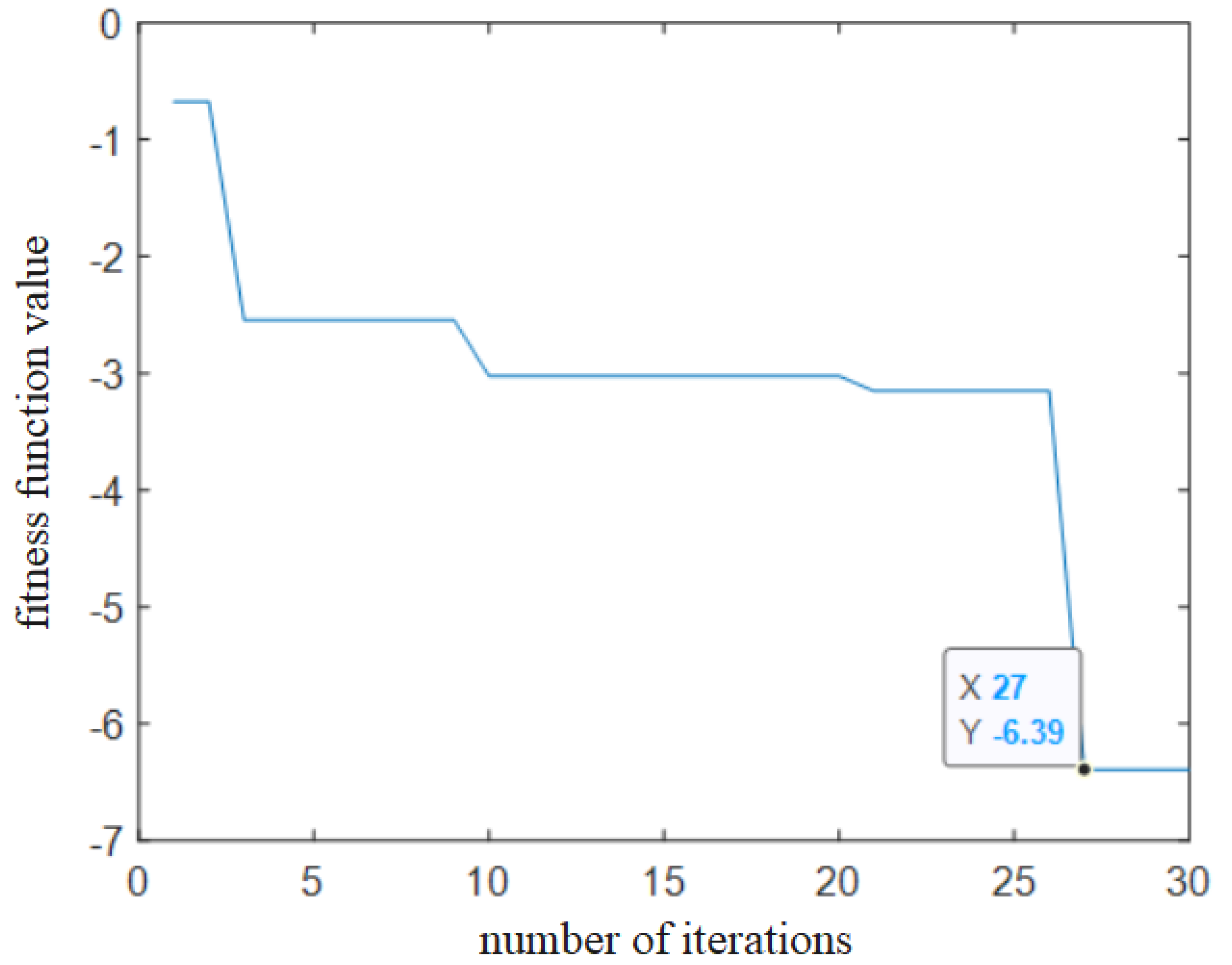

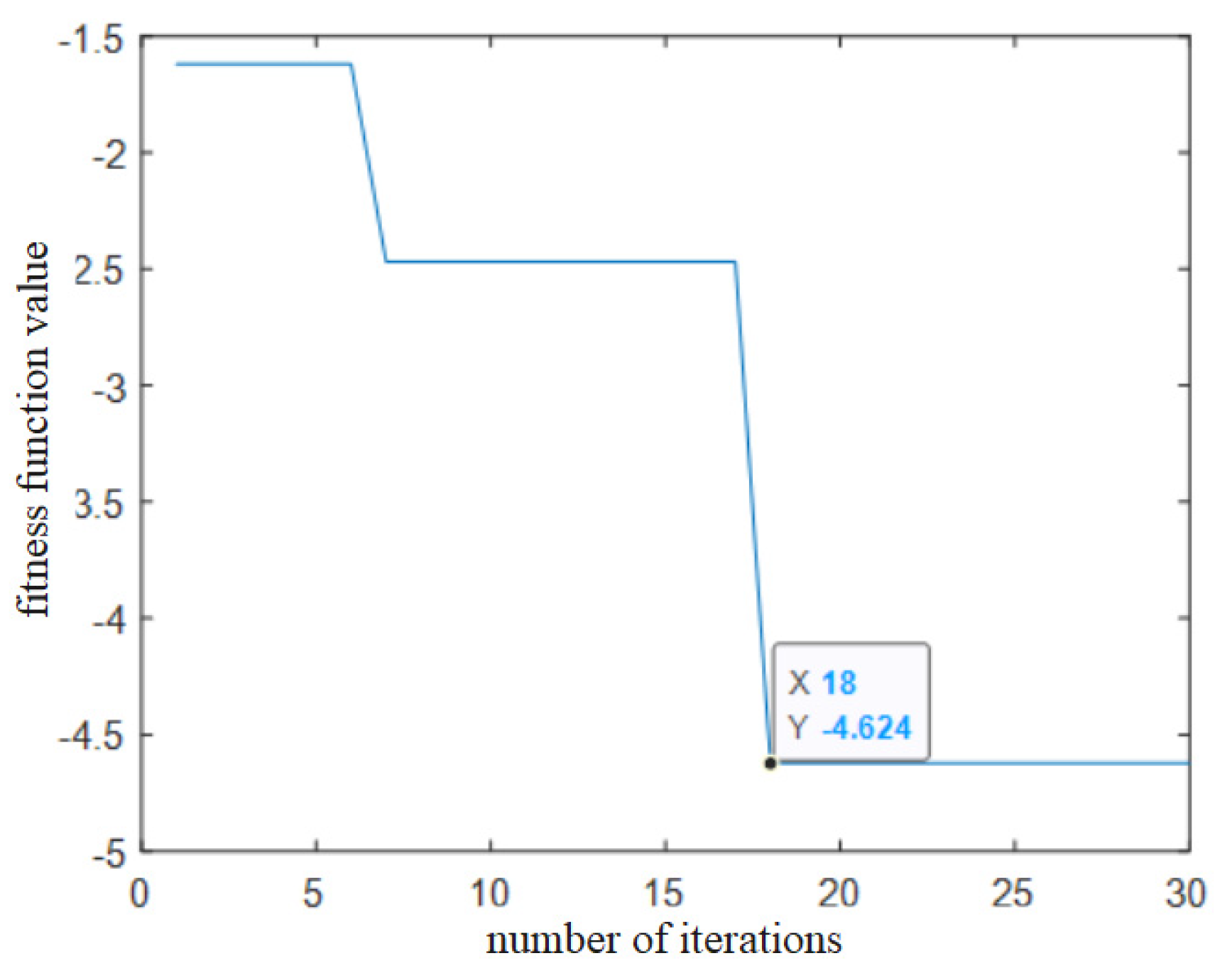


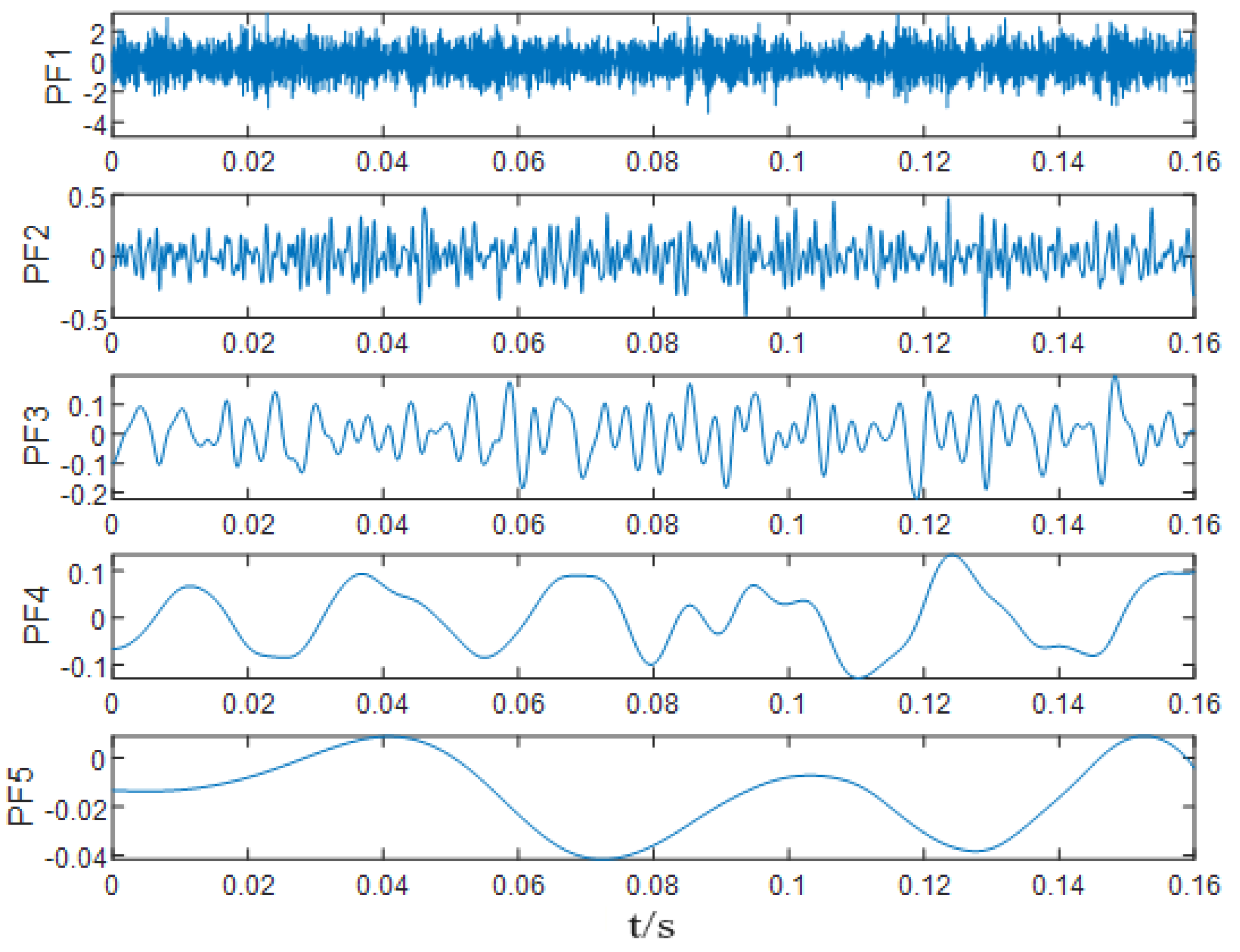
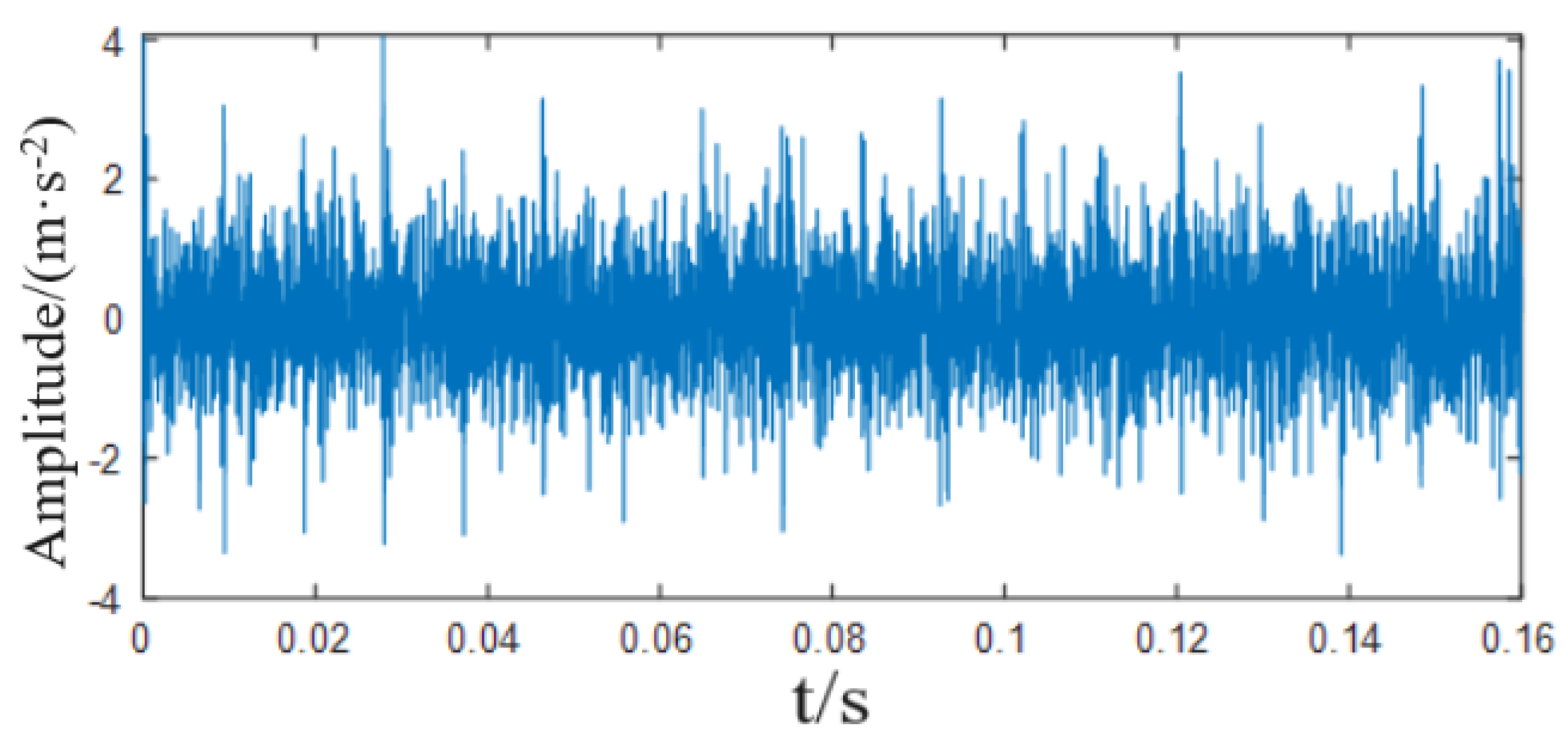




| PF | PF1 | PF2 | PF3 | PF4 | PF5 | PF6 |
|---|---|---|---|---|---|---|
| kurtosis | 2.97 | 2.87 | 2.66 | 2.78 | 1.93 | 1.61 |
| Correlation coefficient | 0.91 | 0.4 | 0.16 | 0.07 | 0.04 | 0.04 |
| Parameter | Value |
|---|---|
| group number | 30 |
| The maximum number of iterations | 30 |
| number of discoverers | 10 |
| Be aware of dangerous sparrow numbers | 5 |
| safety threshold | 0.8 |
| Parameter | Value | Parameter | Value |
|---|---|---|---|
| Inner race diameter | 29.30 mm | Ball diameter | 7.92 mm |
| Outer race diameter | 39.80 mm | Number of balls | 8 |
| Bearing mean diameter | 34.55 mm | Contact angle | 0° |
| PF | PF1 | PF2 | PF3 | PF4 | PF5 |
|---|---|---|---|---|---|
| kurtosis | 2.83 | 3.34 | 2.8 | 1.84 | 1.93 |
| Correlation coefficient | 0.98 | 0.22 | 0.1 | 0.08 | 0.01 |
Publisher’s Note: MDPI stays neutral with regard to jurisdictional claims in published maps and institutional affiliations. |
© 2022 by the authors. Licensee MDPI, Basel, Switzerland. This article is an open access article distributed under the terms and conditions of the Creative Commons Attribution (CC BY) license (https://creativecommons.org/licenses/by/4.0/).
Share and Cite
Ma, J.; Liang, S. Research on Rolling-Element Bearing Composite Fault Diagnosis Methods Based on RLMD and SSA-CYCBD. Processes 2022, 10, 2208. https://doi.org/10.3390/pr10112208
Ma J, Liang S. Research on Rolling-Element Bearing Composite Fault Diagnosis Methods Based on RLMD and SSA-CYCBD. Processes. 2022; 10(11):2208. https://doi.org/10.3390/pr10112208
Chicago/Turabian StyleMa, Jie, and Shitong Liang. 2022. "Research on Rolling-Element Bearing Composite Fault Diagnosis Methods Based on RLMD and SSA-CYCBD" Processes 10, no. 11: 2208. https://doi.org/10.3390/pr10112208
APA StyleMa, J., & Liang, S. (2022). Research on Rolling-Element Bearing Composite Fault Diagnosis Methods Based on RLMD and SSA-CYCBD. Processes, 10(11), 2208. https://doi.org/10.3390/pr10112208






